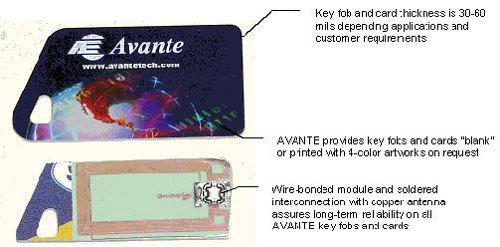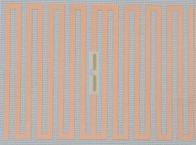Reliable RFID Key Fob
Reliability of Key Fob and Card based on passive RFID technology depends on two factors
One – Consistent high conductive inlay antenna:
- Printed antenna using conductive inks tend to have lower conductivity that is critical for the HF tags operating at 13.56 MHz.
- Due to variations in printing, controlling thickness and ink mixture consistency, there tends to be more variation in conductivity and therefore variation in read distances.
Two – Consistent and low contact resistance between the RFID chip contacts and the inlay antenna:
- Contacts between chips and antenna using conductive adhesive or mechanical crimping are susceptible to the oxidation on the contact surfaces. Oxidation will increase the contact resistance and thus losing the read distance over time.
- Conventional soldered interconnections form inter-metallic joints that are not susceptible to heat, moisture, and other environmental factors.
Traditionally, high temperature stable RFID tags must be made with a rigid substrate such as FR-4 laminate or polyimide flex-tape using soldering interconnection to ensure resistance to high temperature exposure. The rigid substrate limits the flexibility of the RFID tag for use in some applications. The high cost of polyimide flex-tape limits its use in item-level applications. A proprietary molecularly flexible and high temperature resistant RFID flex-tape is now available from AI Technology, Inc. (www.aitechnology.com) This special COUPLER™ substrate comes standard in 3 mil thickness with 1 or 1/2 oz copper foil ready for chemical etching.
AVANTE International Technology, Inc. has made RFID tags using this flex-tape with soldering interconnection for use in its smart badges for tradeshow leads capturing and management applications with outstanding reliability (www.leads-trakker.com). RFID inlets made by AVANTE for 13.56 MHz with a variety of form-factors from 0.5-inch to 10-inch have been made using soldering interconnections joining chip to inlet antennae. They have been tested for high temperature exposure of 150°C without loss in function or read distance. They have also been tested in extreme temperature and moisture conditions such as sterilization at a temperature of 135°C and two atmospheres for over 450 cycles without loss in read distance.
AVANTE has also made RFID tags using this proprietary flex-tape for devices at 2.45 GHz and 915 MHz with the same reliable soldering interconnections.




